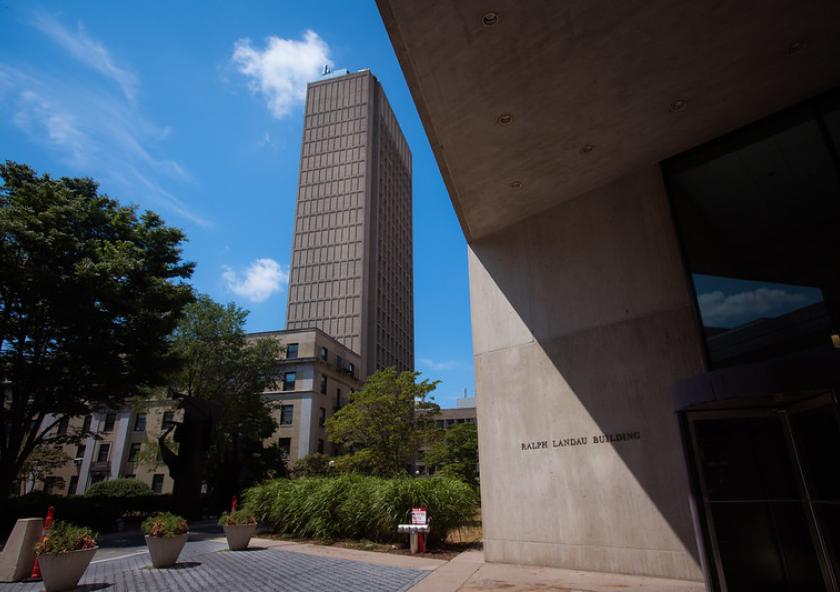
Crafting the roadmap for a heat resilient MIT

It’s been one hot summer. In fact, this summer the hottest 30 days recorded in Boston history, stretching from July 9 through August 8, 2022. These incredibly hot days, which are predicted to only get more numerous, challenge systems we rely on: from cooling and water on demand to pressure on the electrical grid. That’s why MIT is working to design and support a climate resilient MIT—one that fulfills its mission in the face of climate impacts. Fast Forward: MIT’s Climate Plan for the Decade calls for the Institute to, “continue to advance climate resiliency plans and mitigation strategies for the campus and publish an adaptation roadmap for the campus by 2025.”
While both flooding and heat are key climate risks that inform MIT’s designs for resiliency, heat presents a unique challenge and opportunity for adaptation measures says Ken Strzepek, MITOS Faculty Fellow and Research Scientist with the Center for Global Change Science and the MIT Joint Program on the Science and Policy of Global Change. “For resiliency, we prepare for events like the 100-year flood, but we might not see that 100-year event within the next 80 or 100 years,” he explains. “But with heat everything we have seen statistically that heat is at an increase over time, which gives us an opportunity to really understand how we need to design a campus that is resilient to heat risk in 2050 and 2060.” Strzepek is among researchers, students, staff, and faculty working to develop the resiliency roadmap and plan for MITs current and future heat and flood risk. We connected with him recently to talk about this work focused on heat.
What projects are you working on in support of this adaptation roadmap, specifically focusing on heat?
There are two main aspects of climate change that Fast Forward focuses on: mitigation and resilience. MIT is doing large amounts of work in mitigation to reduce greenhouse gases, but resilience is something different. Resilience addresses the fact that analyses shows that no matter what we do, there will be some large impacts of climate change felt by 2050 or 2060 and we need to prepare for whatever those impacts are going to be.
Some of these impacts will come from heat events—days of very high heat and heatwaves. Heatwaves are becoming more frequent and are predicted to continue to be more frequent. To create this adaptation roadmap when planning for heat risk, we need to answer several questions: What are the potential impacts from heat by mid-century and beyond? How should heat risk impact the design of any new buildings or landscape architecture? How should we change our operations to respond to this? Are there behavior modifications we can undertake? Are there things we can do now to change the campus to be more resilient?
How is MIT working to answer those questions?
We have multiple activities going on now to begin to address these questions. First, we engaged a consultant, Resilient Analytics, to do what is called a screen study to help us understand what areas of campus and our community we need to prioritize in this roadmap work. Their study is evaluating the potential impacts from prolonged and extreme heat to MIT’s community, building, and landscape systems. The study is also informed by how heat has impacted other educational campuses throughout the US. We expect the results from this in September and will then explore recommended next steps.
Additionally, were working to collect on-the-ground data from MIT’s own campus related to heat risk. Much of building design and standards around heating and cooling requirements rely on historical weather data which tells us how much heating or cooling power we need for a building based on its size and this information. This is a challenge in two ways. First, this historical data may no longer be the most accurate as climate change impacts patterns going forward. Second, much of this data is collected at Logan Airport where we hypothesized there is significant cooling coming from its coastal location, causing this data to not be accurate for the dense urban Cambridge area where MIT is located. We began collaborating with MIT graduate student Lauren Futami in 2021, who is working to capture heat data around campus. She has placed six heat sensors in different locations around campus to capture that data. In her reported data, we’re already seeing the temperature difference among campus locations as sometimes significantly different from the temperature data from Logan. To complement this, we’ve also teamed with Senseable City and their City Scanner technology which places heat sensors on moving fleets, like they are now doing with the MIT campus recycling truck. These sensors travel a large area of campus and are helping to give us a more complete picture of heat risk when paired with what Lauren is capturing. Last, we’re looking at new climate modeling data from the Intergovernmental Panel on Climate Change (IPCC) which is helping us see how weather patterns in shoulder seasons and specifically months September and May—which are big months at universities like MIT—are expected to change.
How could this data inform how MIT moves forward with regards to heat?
This work is in the early stages, but it will help to inform development of the roadmap and actions we can take at the layers of resiliency, which are the community (people), buildings, utility, and site. At the community level, it could inform where and when classes are scheduled to make the best use of cooler areas and stay out of the hotter spaces on campus. At the building level, it will inform building design and landscaping and hardscaping choices. We’re still very much working to understand the nature of the risk faced by campus and how to prioritize the work within the roadmap.

